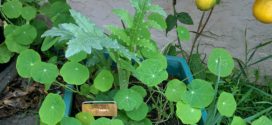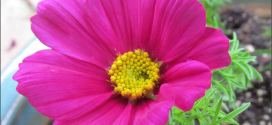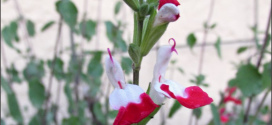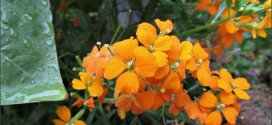From the north of Italy, the artichoke of aristocrats. This choke has small oval slightly elongated head 3 inches wide by 5 inches long. mouthwatering flavor. Fruit is more elongated than the green globe type. The edible thistle first appeared in Italy and Sicily as early as 200-300 B.C. It may be a descendant of C. cardunculus, the wild cardoon …
Read More »Tag Archives: Summer
Yarrow
Yarrow (Achillea spp.) adds bright spots of color to the garden in summer and fall. My mother has always had the tall yellow yarrow in her Almaden Valley garden. It complemented the blue and white flowers of Mexican Sage. The flower heads are large, flat-topped umbels packed with tiny flowers. This hardy, drought-resistant perennial still thrives with poor soil and …
Read More »Cosmos
Common Cosmos, Mexican Aster. Cosmos are annuals, grown for their showy flowers. The flowerheads may be bowl– or open cup–shaped and are atop of long stems. Cosmos are easy to grow and make good border or container plants. They make for good decorations in flower arrangements and also attract birds, bees, and butterflies to your garden. Family: Asteraceae (ass-ter-AY-see-ee) (Info) …
Read More »Pansy
Pansy, Viola x wittrockiana Family: Violaceae (vy-oh-LAY-see-ee) (Info) Genus: Viola (vy-OH-la) (Info) Species: x wittrockiana (wit-rok-ee-AH-na) (Info) Category: Annuals Tropicals and Tender Perennials Height: under 6 in. (15 cm) 6-12 in. (15-30 cm) Spacing: 6-9 in. (15-22 cm) Hardiness: USDA Zone 7a: to -17.7 °C (0 °F) USDA Zone 7b: to -14.9 °C (5 °F) …
Read More »Salvia – Hot Lips
Autumn Sage, Salvia x jamensis ‘Hot Lips’ Family: Lamiaceae (lay-mee-AY-see-ee) (Info) Genus: Salvia (SAL-vee-uh) (Info) Species: x jamensis Cultivar: Hot Lips Synonym:Salvia microphylla Category: Tropicals and Tender Perennials Height: 36-48 in. (90-120 cm) 4-6 ft. (1.2-1.8 m) Spacing: 18-24 in. (45-60 cm) Hardiness: USDA Zone 8a: to -12.2 °C (10 °F) USDA Zone 8b: …
Read More »Wallflower
From fast-growing clumps of strap-shaped foliage sprouted in early March, an abundance of bud clusters appear in April, which quickly pop open in an endless succession of very fragrant, absolutely neon-bright orange blooms well into mid-summer. Siberian Wallflower harmonizes beautifully with its fellow biennial Forget-Me-Not (Myosotis), the warm orange and cool sky blue. Despite the common name, Siberian Wallflower originated …
Read More »Tigridia
Tigridia, Tigridia alpestris Family: Iridaceae (eye-rid-AY-see-ee) (Info) Genus: Tigridia (ty-GRID-dee-uh) (Info) Species: alpestris (al-PES-triss) (Info) Category: Bulbs Perennials Height: 18-24 in. (45-60 cm) Spacing: Unknown – Tell us Hardiness: Unknown – Tell us Sun Exposure: Full Sun Danger: Unknown – Tell us Bloom Color: Purple Maroon (Purple-Brown) Bloom Time: Unknown – …
Read More »Calandrinia Spectabilis
Calandrinia is a plant genus that contains many species of purslane, including the redmaids. The genus was named for Jean Louis Calandrini, an 18th-century Swiss botanist. It includes around 150 species of annual herbs which bear colorful flowers in shades of red to purple and white. Plants of this genus are native to Australia, Chile, and western North America. This …
Read More »Lily – Asiatic
Asiatic lilies (Lilium asiatic) produce showy blooms that range in color from pastel to brilliant shades of pink, red or orange and include every color except for blue. These flowers appear atop a tall stalk that resembles the top of a pineapple and form a cluster of blooms that open in late spring to early summer. With proper care, these …
Read More »Lily – Spider
Hymenocallis is a wonderful genus of bulbous amaryllids…native mostly to the US, Mexico, and Central America. Hymenocallis (spider lilies) are an easy-to-grow moisture-lover that are a reliable perennial wildflower in the garden. Spider lilies are a tough, low maintenance plant which makes it perfect for rain gardens. In the wild many Hymenocallis (spider lilies) often grow in or near water …
Read More »








